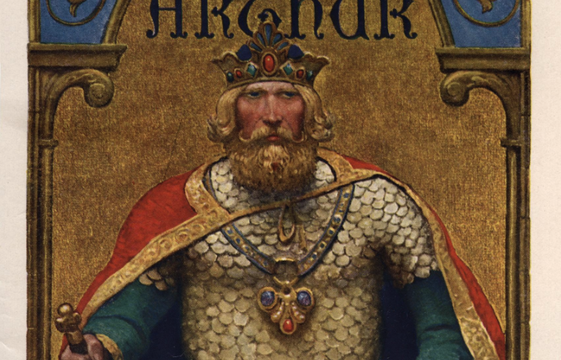
King Arthur.NC Wyeth / Public Domain
Many and various tales about the legend of King Arthur have continued to arise throughout history - but what can we take as real and what can we dismiss as lore?
There's a story that some like to think is true. During the 13th century, an abbot speaking to a congregation of monks found that many of his listeners had fallen asleep. In desperation, the abbot raised his voice and declared: "I will tell you something new and great. There was once a mighty king, whose name was Arthur. . . ." The words had an electrifying effect. Though the monks couldn't stay awake to hear the abbot's thoughts on holy matters, they perked up at the mention of the magical name Arthur.
Arturus, military leader
There's now general acceptance that behind the legendary figure of Arthur stands a real historic personage, a great leader named Arturus, who championed the Celtic Britons' cause against the Anglo-Saxons in the 5th century. However, his name doesn't appear in any reliable history of the period, probably because Arturus was not his proper name, but a title meaning Bear.
Although the Saxons finally conquered Britain, the Celts remained strong in Cornwall, Cumberland, and Wales. There, the Celtic people retained a degree of independence and kept alive the memory of old champions like Arturus. Celtic bards traveled from court to court recounting folk tales of the past. Over time, Arturus, the military leader, became King Arthur of England.
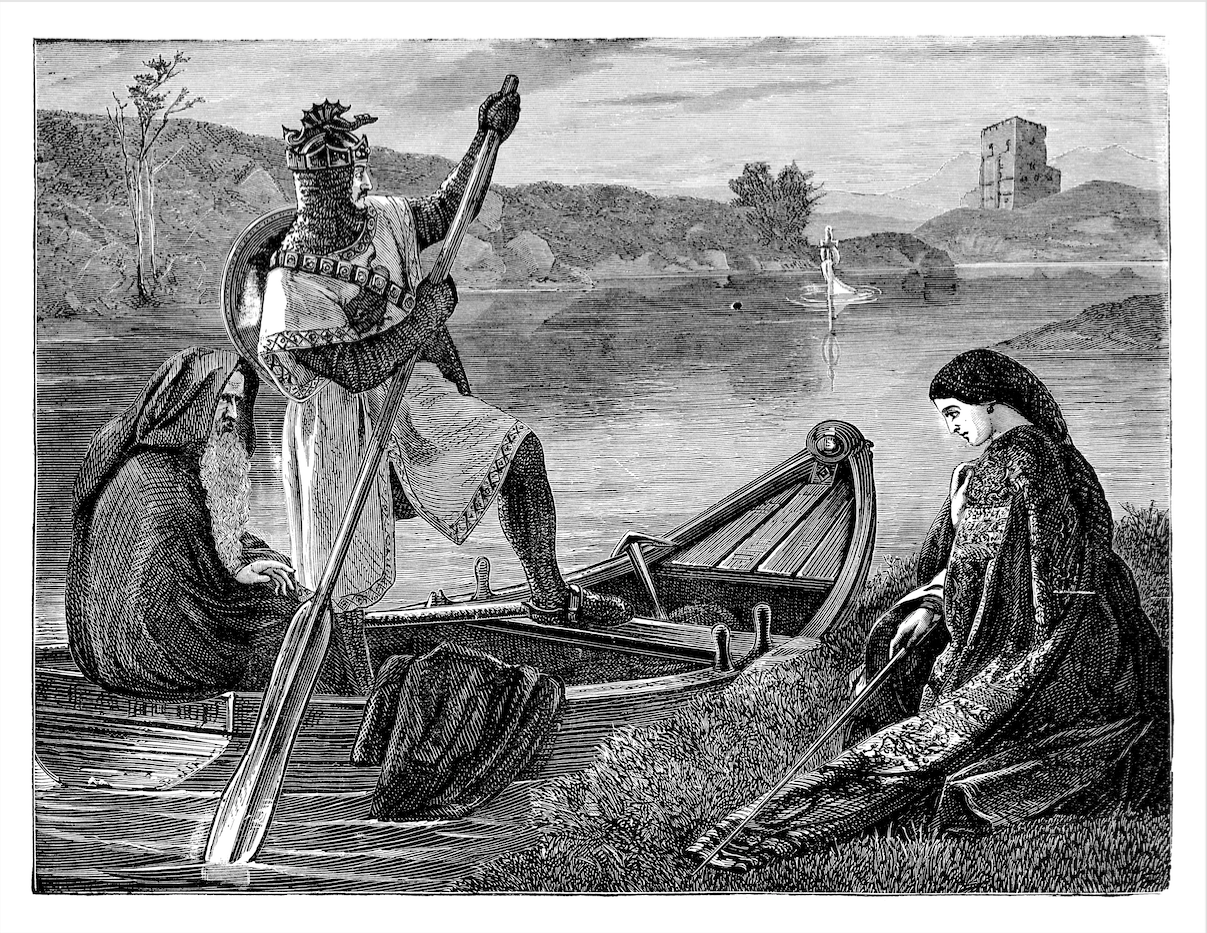
King Arthur on boat with Merlin going to retrieve the sword - Scanned 1881 Engraving
Some historians believe Arthur was Dux (Duke) of Britain, a Roman title. However, by AD 500, such titles had become vague and 'King' was the customary designation of Celtic leaders. When Roman rule faded on the island, the old kingly families of the tribes and regions re-emerged.
From hints found in ancient records, we can glean a picture of Arthur as a warrior who was successful for a time, only to die tragically in a civil war after a mysterious Battle of Camlann in AD 537 or thereabouts. Arthur's father may have been Ambrosius Aurelianus, himself a Duke of Britain. The decades between Ambrosius' death, sometime after 495, and Arthur's own demise some 40 years later were a time of shifting fortune and wide-ranging struggles. This may explain the myriad of places in Britain that claim a connection to the legendary king.
The fanciful histories of King Arthur
In the centuries that followed Arthur's death, fanciful histories fleshed out the few reliable facts about the 'King' with a whole body of literature that created an enduring legend. Foremost among these was the Historia Regum Britanniae (History of the Kings of Britain), written in 1135 by Geoffrey of Monmouth. Also in the 12th century, the monk Nennius, in his Historia Brittonum (The History of the Britons) listed Arthur's battles against Germanic invaders - the Saxons and the Angles - during the late 5th and early 6th centuries. Later, in 1160, the French writer Chretien de Troyes established King Arthur as a fashionable subject of romantic literature by introducing medieval chivalry and courtly romance into the tales. Not only did de Troyes create many of the knights, including Sir Lancelot, he also used the more lyrical sounding Guinevere as the name for Arthur's queen and chose Camelot for the name of his court.
But the story of King Arthur as we know it today is mostly the work of Sir Thomas Malory. In his Le Morte d'Arthur (The Death of Arthur), printed in 1485, he retold many of the tales that had first been circulated by word of mouth and were then written down. He dressed Arthur in the fashions of his own times, transforming him into a 15th-century hero. As Homer was to Odysseus, so was Sir Thomas Malory to Arthur.
The modern tale of King Arthur
Malory's text transports the reader to a dreamland of castles and kingdoms in which the love of adventure was reason enough to wage battles. Though these adventures are as real as a boy's dream, they're as difficult to place in the latitude and longitude of today's world.
Le Morte d'Arthur opens with Arthur conceived as the illegitimate son of Uther Pendragon (literally 'the Head Dragon' or King of Britain). After being raised in secret, Arthur proves himself, king, by drawing a sword from a stone. He marries Guinevere, founds the Knights of the Round Table at Camelot and begets a son, Mordred, in unknowing incest. Following 12 years of prosperity, Arthur's knights commence a quest to discover the Holy Grail, during which time Lancelot, his chief knight, consummates an adulterous affair with Queen Guinevere. Ultimately, the couple is discovered and Arthur pursues Lancelot into France, leaving Mordred behind as regent.
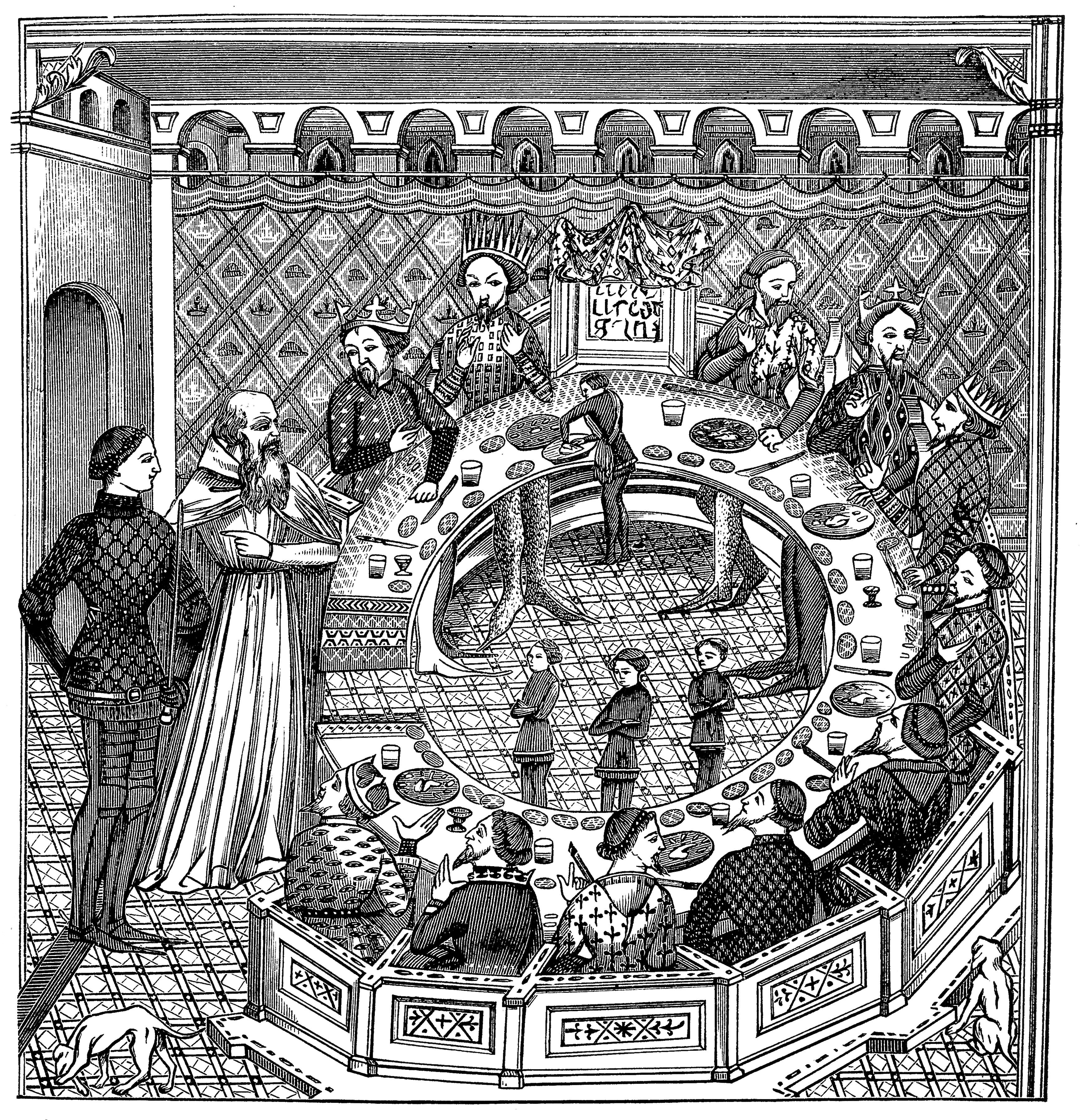
Illustration of a King Arthur and his Round Table
At the end of the story, Arthur discovers an attempt by Mordred to seize the throne and returns to quash the rebellion. In a final battle, Mordred dies and Arthur receives a mortal wound, after which he is transported by barge to the Vale of Avalon. Following the battle, Sir Bedivere reluctantly returns Arthur's sword Excalibur to the Lady of the Lake, while both Lancelot and Guinevere enter holy orders and live out their lives in peace.
Tracing the footsteps of King Arthur
The British Isles abound with landmarks linked to the Arthurian legend. To try to unravel the mystery surrounding him, I visited some of these places. I started with Winchester, the old Roman city of Venta Belgarum, site of the Great Hall and depository of the most famous of all Arthurian relics, the Round Table.
The solid oak tabletop measures 18 feet in diameter and weighs approximately one and a quarter tons. It hangs on the wall, looking like an enormous dartboard with green and white segments painted onto it to indicate the places where the king and his knights once sat. In Malory's day, many considered it to be the genuine article, and historians believed Winchester Castle to be the site of Arthur's fortress, Camelot.
Unfortunately, the existing castle isn't nearly old enough to have been Arthur's. Tests prove Edward III constructed the table, probably in 1344, when he conceived the notion of an order of chivalry based on the knights of the Round Table, as depicted in the popular romances. It was possibly used for celebrating the popular Arthurian festivals in which noblemen indulged.
King Henry VIII ordered the table painted in 1522 to honour a visit by the Holy Roman Emperor, Charles V. The image of Arthur is actually modeled on a very youthful Henry VIII seated in full royal regalia. A Tudor rose marks its centre.
Legend says that Merlin, the magician, conjured the table for Uther Pendragon, Arthur's father. On Uther's death, Merlin gave the table to Arthur. The idea of a table where all were equal, where no man sat in state above his peers appealed to the romantic idealism which, especially in Victorian times, surrounded the knightly legend. In reality, any leader of Arthur's time would have had to impose a fierce discipline or risk being deposed.
In Malory's Le Morte d'Arthur, Camelot was Winchester. Local folklore says it was Colchester. The Romans, after all, called the town Camulodunum. In both cases, there's little to support the claim. The most likely site of Camelot, backed by some archaeological evidence gathered in the 1960s, is Cadbury Castle, an Iron Age hillfort near Yeovil, high above the plains of Somerset, near the village of Queen Camel. John Leland, an antiquarian during Henry VIII's reign, wrote that local people often referred to the remains of this fortified hill as 'Camalat--King Arthur's Palace'.

Arthur's Seat from Calton Hill, Edinburgh, Scotland
Excavations conducted by archaeologist Leslie Alcock revealed wattle and daub huts within an 18-acre enclosure on top of the hill. Two shrines, a metalworkers' area, furnaces, smiths' tools, and finished weapons were also unearthed. Evidence shows that the entrance to Camelot was by way of a cobbled roadway, ten feet across, which passed through a timber-lined passage beneath a gate tower raised on posts and tied in with the rampart and sentry walkway on either side. Massive pairs of doors closed off either end of this passage. Large quantities of dressed masonry from derelict Roman buildings formed the rampart itself.
Exploring Arthur's Palace
From findings near the site of Arthur's Palace, it became clear that Cadbury had been at one time a stronghold of great importance, revamped from its original pre-Roman state and turned into a Dark-Age fortress.
The lane leading up to the hilltop winds gently upwards through an avenue of majestic trees. At the summit, a grassy plateau affords a view to rival any in England.
There have been many ghostly sightings around Cadbury, and indeed, I felt the coldness of spirits as I climbed around on the hill. Below me, I saw the remains of an ancient track that leads towards Glastonbury may have been used by Arthur and his knights travelling to and from Camelot. Locals say that on winter evenings the knights still ride along this causeway, bridles and harness jangling, to go hunting. Those who claim to have witnessed this fearsome sight talk of seeing lances that glow in the dark and hearing the spine-tingling baying of hounds.
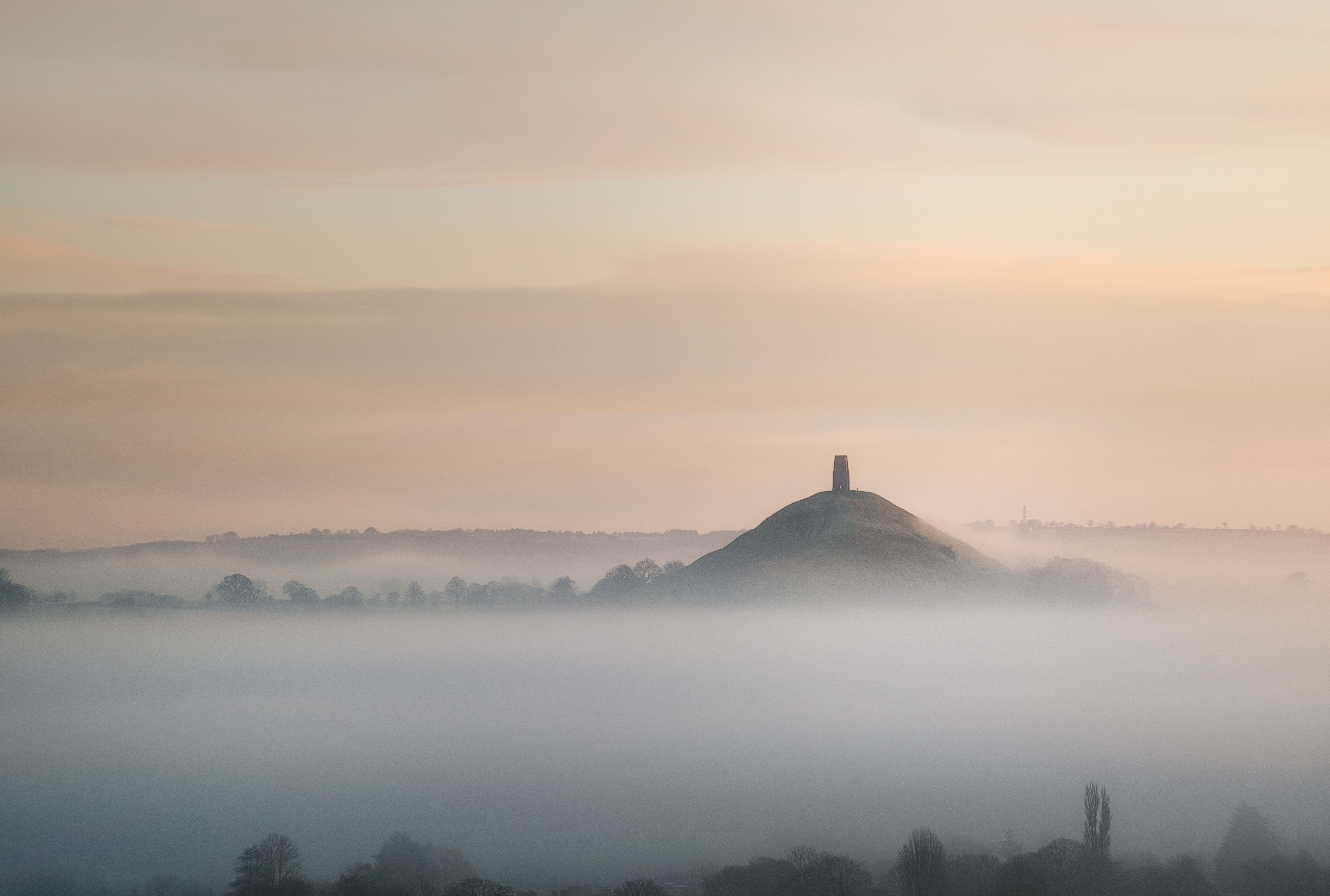
Misty winter scenery of iconic Somerset landmark - Glastonbury Tor
Not far from Cadbury Castle, locals say, along the banks of the River Cam on Salisbury Plain, both Arthur and Mordred fell in the Battle of Camlann. Farmworkers once unearthed a large number of skeletons in a mass grave west of the castle, suggesting a mighty battle took place. Standing on the spot, I could only dream of knights in armour, the clash of their swords sounding the spirit of defiance and justice.
Afterward, I headed to Bodmin Moor, two miles south of Bolventor in Cornwall, to visit Dozmary Pool. A mile in circumference, Dozmary Pool is a place of changing mood and beauty, a place of mystery and magic. Standing on its rim as the early morning mist began to rise, I could imagine Sir Bedivere throwing Excalibur into the lake, from which a hand rose and caught the magical sword, as King Arthur lay dying.
The story of Excalibur being thrown to the Lady of the Lake probably originated in Celtic practices. Archaeologists have found many swords that have long ago been thrown into sacred lakes as votive offerings to the water goddess, the goddess of healing.
Read more
Like these sites traditionally linked to Arthur's death, his reputed birthplace at Tintagel Castle also lies in Cornwall, along its northern coast. The ruins of the castle stand just outside the village, on what's virtually an island surrounded by foaming seas, once linked to the mainland by a narrow ridge of rock.
Visitors to the ruins must cross a footbridge and ascend a long flight of steps. The sound of waves crashing against the rocky shore 250 feet below, combined with the wind, full of the scent of salt air, make for an exhilarating crossing. The ruins only hint at the castle's former grandeur. All that remains is a dramatic archway and several sections of walls pocked with holes that once support building timbers.
Merlin's cave supposedly lies directly below the ruins, piercing the great cliff, cutting through to a rocky beach on the other side of the headland. Here, under grey skies, the roar of the Atlantic can be as loud as the wind on a stormy day. At Tintagel, the line dividing fact and legend is often thin and blurred.
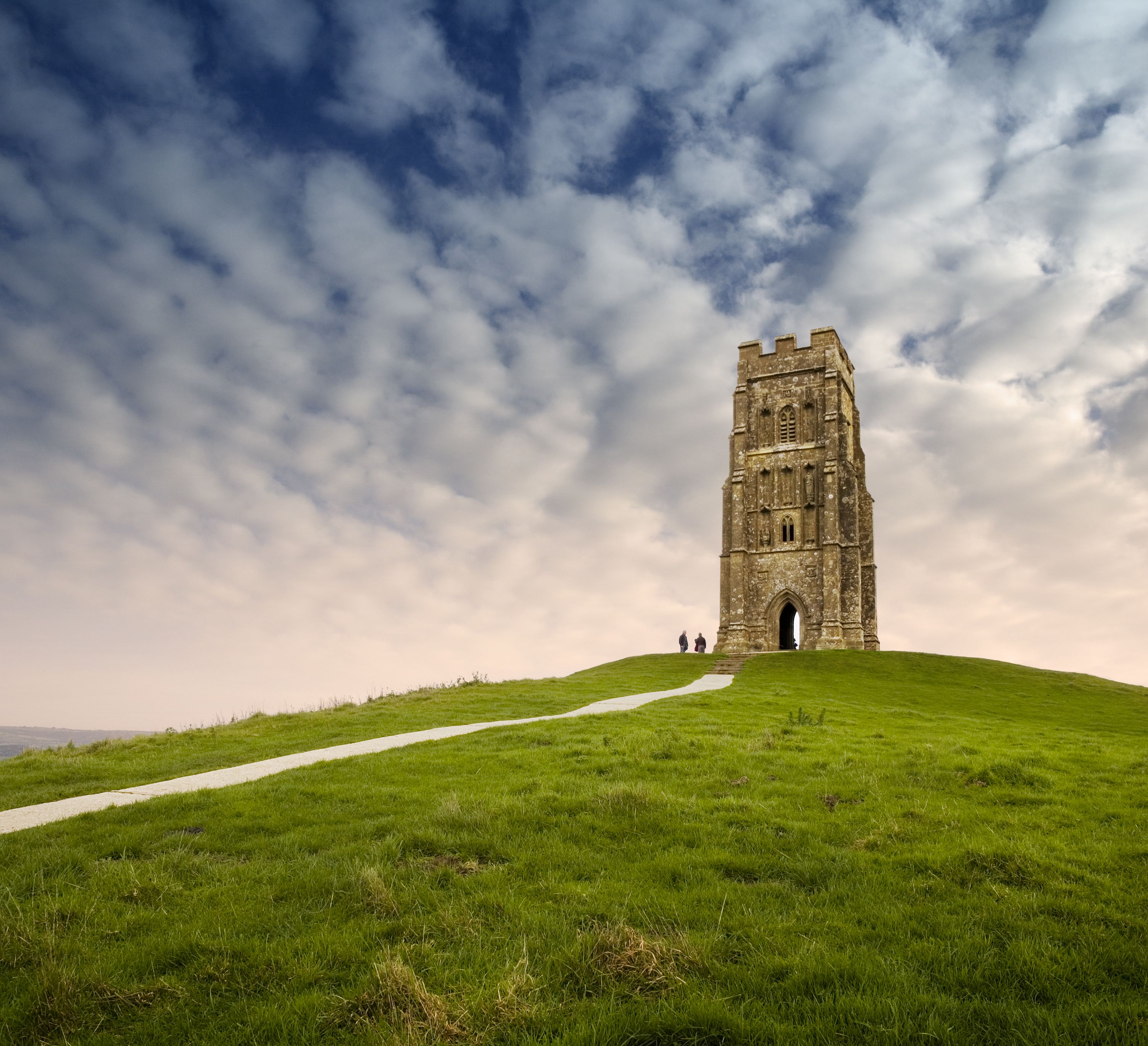
The summit of Glastonbury Tor
The earliest mention of Tintagel in association with King Arthur appears in Geoffrey of Monmouth's Historia, in which Uther Pendragon falls in love with Ygerna, wife of Gorlois, Duke of Cornwall. To keep her away from Uther's grasp, her husband sends her to Tintagel. Infuriated, Uther goes to Cornwall, persuading Merlin to prescribe a magic brew enabling him to look like Gorlois. Thus disguised, he has no difficulty in entering the castle to sleep with Ygerna, whereby Arthur is conceived.
The thousands of Arthurian pilgrims who come to Tintagel seem unaffected by the fact that the present castle dates only from the early 12th century, and thus couldn't possibly have been Arthur's birthplace. Archaeologists have also found the remains of a 6th-century Celtic monastery founded by St. Juliot on the site, but there's no evidence to associate it with the legendary king.
The true battlefield of Camlann
Not far from Tintagel stands Slaughter Bridge, near Camelford. This too has been cited as the true battlefield of Camlann, Arthur's last battle, in which he kills Mordred with a spear, but receives a mortal wound in return. Upstream in a nook lies a stone covered with moss and strange lettering, which the Cornish call Arthur's grave. More likely, it's that of a Celtic chieftain. Local lore says that Arthur didn't die at Slaughter Bridge, but was instead incarnated into the soul of a chough, so that he may someday return.
The legends say Arthur's half-sister, Morgan Le Fay, carried the wounded Arthur off on a barge to the Isle of Avalon, a Celtic word meaning 'the island of apples.' Many believe his final resting place to be in the West Country market town of Glastonbury. Nestled amidst a small cluster of hills, Glastonbury was almost an island in early Christian times when much of the surrounding countryside was a swamp. The town's highest hill, Glastonbury Tor (an old West Country word meaning hill) with a solitary tower at its summit, can be seen for miles around. Tradition has it that the Tor, often surrounded by mist, was the Isle of Avalon.
It's difficult to imagine Glastonbury Tor without its distinctive tower, but until Norman times, when the monks built a chapel to St. Michael, the hill remained bare. An earthquake destroyed the chapel in 1275, and it lay in ruins for 50 years until the Abbot of Glastonbury, Adam Sodbury, rebuilt it. The monks added a tower, now all that remains, in the 15th century.
Though the search for Arthur's grave brought me to Glastonbury, once there, the majesty of the ruins made me want to linger. The Abbey ruins, set among manicured lawns and imposing trees, are all that remain of one of medieval England's greatest monasteries. None of the walls left standing is older than 1184. On 24th May of that year, a great fire destroyed the monastery. Many believe the Abbey was the home of the first Christian community in England. Evidence shows that monks and hermits may have lived there as early as the 5th and 6th centuries.
Glastonbury's link with King Arthur arose as a result of a discovery said to have been made in the late 1100s within the grounds of the abbey. In 1190, during reconstruction after the fire, the monks claimed to have discovered a grave. They dug down seven feet before reaching a stone slab, below which lay a lead cross, bearing the Latin words: Hic iacet sepultus inclytus Rex Arthurius in Insula Avallonia cum uxore sua secunda Wenneveria. (Here lies the renowned King Arthur in the isle of Avalon with his second wife Guinevere.)
The monks dug nine feet further and found a hollow tree trunk containing the bones of what appeared to be an immensely tall man, plus some smaller bones and a scrap of yellow hair. He appeared to have 10 wounds, all healed except one.
The discovery of the grave was, to say the least, timely, for the monks were in desperate need of funds for rebuilding. And the only sure way to raise money was to attract large numbers of pilgrims.
Today, a simple sign on the neatly trimmed lawn of the abbey marks the grave from which the royal remains disappeared after King Henry VIII ordered the abbey's dissolution in 1539.
Was King Arthur real? Did he exist as a true king? Was he a Celtic hero, ruler, and conqueror or the romantic medieval knight in shining armour? So many theories have been suggested, so much written about him over the centuries that even though the truth may have become somewhat distorted, it's hard to imagine such a person couldn't have existed to spawn all those tales.
The tales of King Arthur and his court continue to fascinate countless readers, perhaps because we know so much of the legend and so little of the truth. The most famous sites traditionally associated with Arthur cannot withstand historical scrutiny. While there's no document to prove Arthur's existence, and archaeologists have found no objects bearing his name, there's nothing to say that he didn't exist.
Then again, the legend of King Arthur may just be a myth - but if so, it's a good one.
Read more
* Originally published in September 1998.





Comments